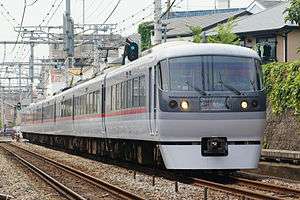Seibu 10000 series
The Seibu 10000 series (西武10000系) is an electric multiple unit (EMU) train type operated by the private railway operator Seibu Railway on limited express services in the Tokyo area of Japan since 1993.[1]
| Seibu 10000 series | |
|---|---|
 10000 series on a Chichibu service in June 2008 | |
| Manufacturer | Hitachi |
| Replaced | 5000 series |
| Constructed | 1993–2003 |
| Entered service | 6 December 1993 |
| Refurbished | 2003–2008 |
| Number built | 84 vehicles (12 sets) |
| Number in service | 84 vehicles (12 sets) |
| Successor | Seibu 001 series |
| Formation | 7 cars per trainset |
| Operator(s) | Seibu Railway |
| Depot(s) | Kotesashi, Minami-Iriso |
| Line(s) served | Seibu Ikebukuro Line, Seibu Shinjuku Line |
| Specifications | |
| Car length | 20 m (65 ft 7 in) |
| Doors | One per side |
| Maximum speed | 105 km/h (65 mph) |
| Traction system | Resistor control Variable frequency (3-level IGBT) (set 10112) |
| Electric system(s) | 1,500 V DC |
| Current collection method | Overhead line |
| Braking system(s) | Dynamic braking |
| Track gauge | 1,067 mm (3 ft 6 in) |
Operations
Branded as "NRA" or "New Red Arrow", the trains are used on Koedo services from Seibu-Shinjuku in Tokyo to Hon-Kawagoe and on Musashi and Chichibu services from Ikebukuro in Tokyo to Hannō and Seibu Chichibu Station.[1]
Formation
As of 1 April 2012, the fleet consists of 12 7-car sets, formed as follows.[2]
| Car No. | 1 | 2 | 3 | 4 | 5 | 6 | 7 |
|---|---|---|---|---|---|---|---|
| Designation | Tc1 | M1 | M2 | T | M3 | M4 | Tc2 |
| Numbering | 10100 | 10200 | 10300 | 10400 | 10500 | 10600 | 10700 |
Cars 2, 5, and 6 each have one single-arm pantograph, except set 10112, which has pantographs on cars 2 and 5 only.[2]
History
The first two trains delivered were introduced in December 1993 on Koedo services from Seibu-Shinjuku in Tokyo to Hon-Kawagoe, replacing the former 5000 series Red Arrow trains.[3]
A further three trainsets were delivered in 1994 and introduced on Chichibu services from Ikebukuro in Tokyo to Seibu-Chichibu on 15 October 1994.[3]
The trains were refurbished internally between 2003 and 2008, and the old seats were re-used in Chichibu Railway 6000 series and Izukyu 8000 series trainsets.[4]
Interior
The sets are monoclass with 2+2 abreast reclining seating. Seat pitch is 1,070 mm (42 in).[4]
- Original seating in September 2006
 Interior view showing new seating in January 2009
Interior view showing new seating in January 2009- New seating in September 2006
Livery variations
 Set 10107 in Nagatoro advertising livery in August 2011
Set 10107 in Nagatoro advertising livery in August 2011 Set 10105 in Red Arrow Classic livery in December 2011
Set 10105 in Red Arrow Classic livery in December 2011 Set 10103 in Platinum Express Chichibu Ver. livery in March 2017
Set 10103 in Platinum Express Chichibu Ver. livery in March 2017 Set 10104 in Platinum Express Kawagoe Ver. livery in May 2018
Set 10104 in Platinum Express Kawagoe Ver. livery in May 2018- Set 10109 in Love Live! Sunshine!! livery in September 2017
 Set 10102 in Love Live! Sunshine!! livery in May 2018
Set 10102 in Love Live! Sunshine!! livery in May 2018
References
- 私鉄車両年鑑 2012: 大手15社営業用車両完全網羅 私鉄車両年鑑2012 [Japan Private Railways Annual 2012]. Tokyo, Japan: Ikaros Publications Ltd. February 2012. p. 183. ISBN 978-4-86320-549-9.
- 私鉄車両編成表 2012 [Private Railway Rolling Stock Formations - 2012]. Japan: JRR. July 2012. pp. 60–62. ISBN 978-4-330-29911-2.
- 年鑑'95日本の鉄道 [Yearbook 1995: Japanese Railways]. Japan: Railway Journal. April 1995.
- 2011西武電車最新ガイド [2011 Seibu EMU Guide]. Tetsudō Daiya Jōhō Magazine. Vol. 40 no. 322. Japan: Kōtsū Shimbun. February 2011. pp. 7–35.
External links
| Wikimedia Commons has media related to Seibu 10000 series. |
- Seibu 10000 series "New Red Arrow" (in Japanese)